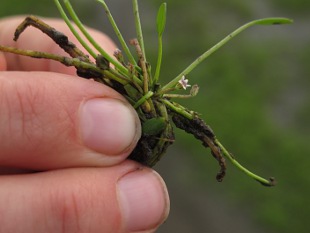
Mudwort (Photo: NTS)
This very small annual plant, whose beautiful but tiny flowers only ever reach up to a tiny 3 milimetres in width, was found to be growing in large patches around the muddy pools usually used for feeding by Threave’s hundreds of ducks and waders.
Mr Lindsay Mackinlay, Trust Ecologist, said: “It is not the easiest plant to monitor as you’re never sure if the next step into the mud will see you disappear up to your waist or result in a wellie boot being stuck fast. However, our efforts were worth it this year as upon arriving at the muddy pools, we discovered hundreds of these small plants growing very well on top of the mud.
“This is the only property where we have it growing and it is only found in a few locations in Scotland. It’s great news and shows that the management of the Trust and its tenant farmer, on this site, is conserving these rare plants.”
Threave estate is a haven for many species of birds, mammals and insects, due to the diversity of habitats within the 1500 acres, including farmland, woodland, marshes and a two mile stretch of the River Dee. It also boasts rich and varied plant life.
Visitors are encouraged to explore the area with walks following an old railway line and an all abilities path down to the River Dee. Five bird hides are situated along the River and marshes providing excellent opportunities to observe resident and migrant species. It is home to seven species of bat and Scotland’s only bat reserve.
